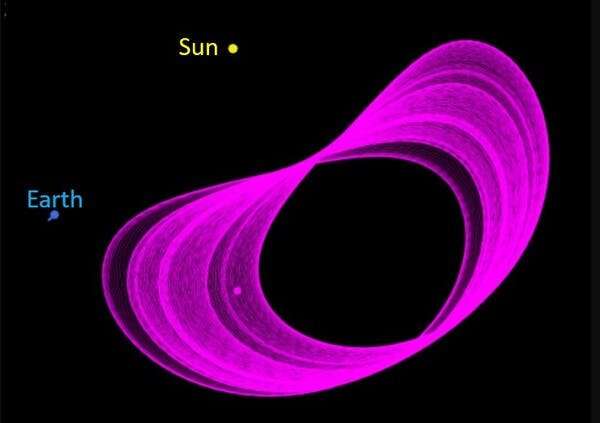
Copernical Team
AI for Earth and Space: Call for researchers and experts
 Frontier Development Lab (FDL) is kicking off its 7th year with a call for applications and the search for an expanded faculty. This year will be the program's biggest and most ambitious to date, with more teams tackling challenges in space, Earth science and energy domains.
FDL is a public-private partnership between NASA, DOE, the SETI Institute, Trillium Technologies, the European Space
Frontier Development Lab (FDL) is kicking off its 7th year with a call for applications and the search for an expanded faculty. This year will be the program's biggest and most ambitious to date, with more teams tackling challenges in space, Earth science and energy domains.
FDL is a public-private partnership between NASA, DOE, the SETI Institute, Trillium Technologies, the European Space Shadow of cosmic water cloud reveals the temperature of the young Universe
 Astronomers have found a new and original method for measuring the cosmic microwave background's temperature when the Universe was still in its infancy. Writing in 'Nature', they confirm in their new study the early cooling of our Universe shortly after the Big Bang and open up new perspectives on the elusive dark energy.
An international group of astrophysicists has discovered a new metho
Astronomers have found a new and original method for measuring the cosmic microwave background's temperature when the Universe was still in its infancy. Writing in 'Nature', they confirm in their new study the early cooling of our Universe shortly after the Big Bang and open up new perspectives on the elusive dark energy.
An international group of astrophysicists has discovered a new metho Taking the temperature of our cosmos, less than a billion years after the Big Bang
 With the IRAM NOEMA telescope array in the French Alps, astronomers have for the first time observed a distant object casting a shadow on the early, hot Big Bang phase of our universe, blocking out some of the light of the so-called cosmic background radiation. The object is a water cloud so distant that we see it as it was a mere 880 million years after the Big Bang. The shadow appears because
With the IRAM NOEMA telescope array in the French Alps, astronomers have for the first time observed a distant object casting a shadow on the early, hot Big Bang phase of our universe, blocking out some of the light of the so-called cosmic background radiation. The object is a water cloud so distant that we see it as it was a mere 880 million years after the Big Bang. The shadow appears because Juno and Hubble data reveal electromagnetic 'tug-of-war' lights up Jupiter's upper atmosphere
 New Leicester space research has revealed, for the first time, a complex 'tug-of-war' lights up aurorae in Jupiter's upper atmosphere, using a combination of data from NASA's Juno probe and the Hubble Space Telescope.
The study, published in the Journal of Geophysical Research: Space Physics, describes the delicate current cycle driven by Jupiter's rapid rotation and the release of sulphur
New Leicester space research has revealed, for the first time, a complex 'tug-of-war' lights up aurorae in Jupiter's upper atmosphere, using a combination of data from NASA's Juno probe and the Hubble Space Telescope.
The study, published in the Journal of Geophysical Research: Space Physics, describes the delicate current cycle driven by Jupiter's rapid rotation and the release of sulphur Youngest pair of asteroids in solar system detected
 An international team of astronomers has discovered a pair of asteroids that split off from their parent body a mere 300 years ago. The duo is exceptional because it is the youngest known "asteroid pair" by at least a factor of ten, it passes close to Earth's orbit, and it has properties that are hard to explain given its young age.
The majority of asteroids in our solar system reside in t
An international team of astronomers has discovered a pair of asteroids that split off from their parent body a mere 300 years ago. The duo is exceptional because it is the youngest known "asteroid pair" by at least a factor of ten, it passes close to Earth's orbit, and it has properties that are hard to explain given its young age.
The majority of asteroids in our solar system reside in t Nobody Tell Elmo About Issole
 America's favorite red monster may not be interested in rocks, but Perseverance can't wait to keep exploring the rocks on Mars!
How does the rover study rocks up-close?
The Mars2020 Perseverance rover is equipped with several instruments that help it investigate the surface of Mars. The PIXL and SHERLOC spectrometers both sit on the Robotic Arm. In addition to measuring spectra and t
America's favorite red monster may not be interested in rocks, but Perseverance can't wait to keep exploring the rocks on Mars!
How does the rover study rocks up-close?
The Mars2020 Perseverance rover is equipped with several instruments that help it investigate the surface of Mars. The PIXL and SHERLOC spectrometers both sit on the Robotic Arm. In addition to measuring spectra and t Astra's planned first launch in Florida scrubbed
 The planned launch of an Astra Space rocket from Florida was scrubbed Saturday after the failure of ground equipment needed to launch.
"Unfortunately, due to a range asset that has gone out of service today, we are going to stand down from today's launch attempt of the ELaNa 41 Mission," said Carolina Grossman, director of product management at the company, during the live broadcast.
The planned launch of an Astra Space rocket from Florida was scrubbed Saturday after the failure of ground equipment needed to launch.
"Unfortunately, due to a range asset that has gone out of service today, we are going to stand down from today's launch attempt of the ELaNa 41 Mission," said Carolina Grossman, director of product management at the company, during the live broadcast. NASA, SpaceX investigate Dragon capsule parachute openings
 SpaceX and NASA officials are investigating a lag in parachute openings during the return of the company's Dragon capsules from the International Space Station with cargo and astronauts, the organizations said during a teleconference Friday.
The return of such capsules was never in jeopardy, and the landing systems performed well during 24 cargo missions and three crewed splashdowns, Sp
SpaceX and NASA officials are investigating a lag in parachute openings during the return of the company's Dragon capsules from the International Space Station with cargo and astronauts, the organizations said during a teleconference Friday.
The return of such capsules was never in jeopardy, and the landing systems performed well during 24 cargo missions and three crewed splashdowns, Sp SpaceX, NASA looking into sluggish chutes on last 2 flights

SpaceX and NASA are investigating a parachute issue that occurred on the last two capsule flights.
One of the four main parachutes was slow to inflate during the return of four astronauts to Earth last November. The same thing happened last week as a Dragon cargo capsule was bringing back science experiments from the International Space Station. In both cases, the sluggish parachute eventually opened and inflated—although more than a minute late—and the capsules splashed down safely off the Florida coast.
Officials for SpaceX and NASA said Friday they want to better understand what's happening, especially before launching another crew in a month or two. They're looking at photographs and inspecting the parachutes for clues, taking "extra caution with this very critical system," said Steve Stich, manager of NASA's commercial crew program.
"We're not taking anything for granted," SpaceX's William Gerstenmaier, a former NASA official, told reporters.
SpaceX's first private flight to the space station, with three ticket-buying businessmen and their retired astronaut escort, is set to blast off from NASA's Kennedy Space Center on March 30. NASA's next astronaut ferry flight would follow on April 15.
Asteroid sharing Earth's orbit discovered. Could it help future space missions?

Research has shown that the Earth trails an asteroid barely a kilometer across in its orbit about the Sun—only the second such body to have ever been spotted. It goes round the Sun on average two months ahead of the Earth, dancing around in front like an excited herald of our coming.
This object, known as 2020 XL₅, was first spotted in December 2020 using Pan-STARRS telescopes on the summit of Haleakala on the Hawaiian island of Maui. But determination of its orbit required follow-up observations using the 4.1-meter SOAR (Southern Astrophysical Research) telescope in Chile.
Based on this data, a team led by planetary scientist Toni Santana-Ros of the University of Alicante in Spain has now announced that 2020 XL₅ is trapped for at least the next several thousand years in an orbit about one of the Sun-Earth "Lagrange points.
